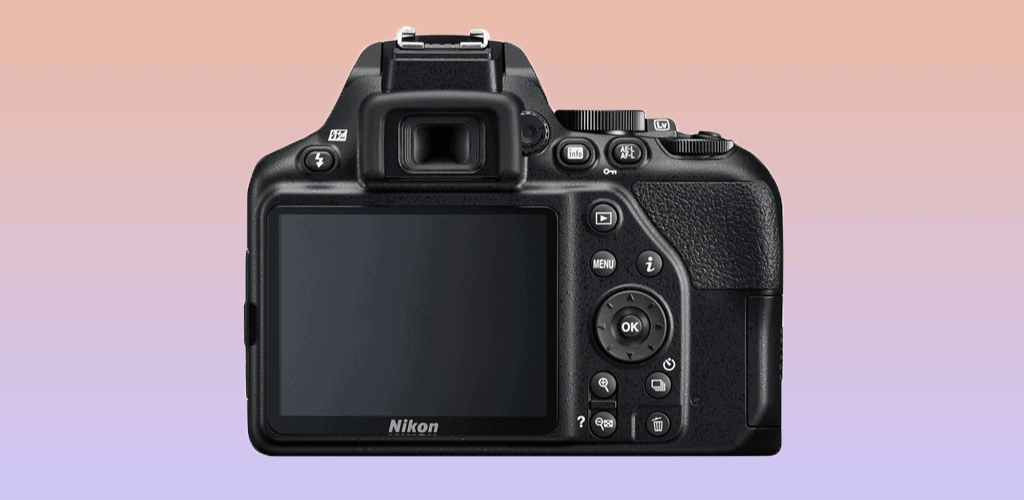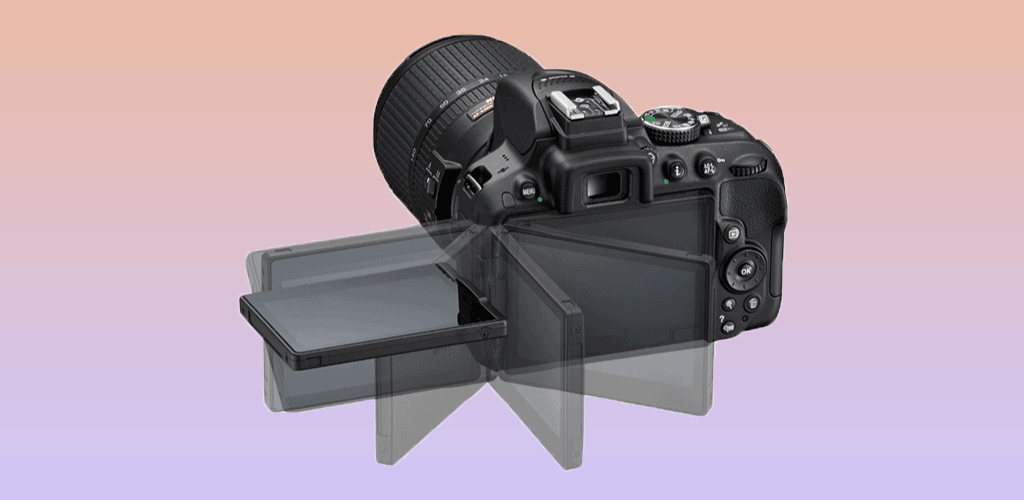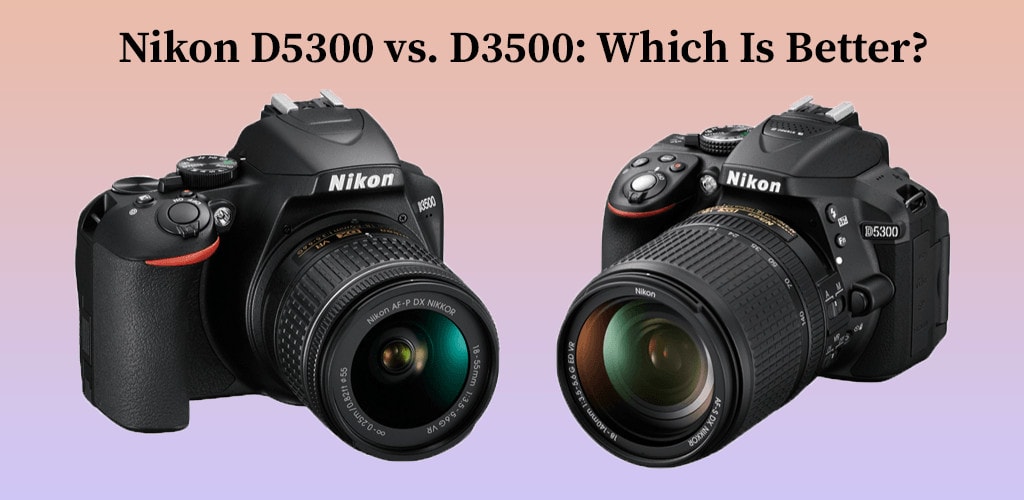New to photography? Or just planning to get a new camera?
You’d probably want to check out entry-level cameras like the Nikon D5300 and Nikon D3500. These two are great for beginners AND more affordable compared to others.
But which one would fit YOU more?
In this review, we’ll be comparing the features of the two Nikon cameras to help you decide!
At a Glance: Nikon D5300 vs. Nikon D3500
Nikon D5300 Features

The Nikon D5300 is an older model of the two. It was announced in the year 2014 as the predecessor of the Nikon D5200.
Despite being an older model, this Nikon model has some pretty notable features:
- 24.2 MP – DX / APS-C Sensor
- No Anti-alias filter
- ISO levels 100 – 12800 (expands to 25600)
- Nikon F Mount (can use 70-300 AF-P DX lenses, has 309 lens options)
- LCD 3.2″ Fully Articulated Screen
- Optical viewfinder with a pentamirror
- 5.0 fps continuous shooting
- No image stabilization
- Full HD – 1920 x 1080 video resolution
- Built-in Wireless Systems
- Built-in Self Timer and Remote Control Options
- Built-in GPS
- Built-in Flash Modes (auto slow sync with red-eye reduction)
- 480g. 125 x 98 x 76 mm
Nikon D3500 Features

On the other hand, the Nikon D3500 was released in 2018. It was announced as an upgraded version of the Nikon D3400.
Just like the Nikon D5300, this model is also an entry-level camera. They almost have similar features.
But here’s a more detailed look into the Nikon D3500:
- 24.2 MP – DX / APS-C Sensor
- No Anti-alias (AA) filter
- ISO levels 100 – 25600
- Nikon F Mount (can use 70-300 AF-P DX lenses, has 309 lens options)
- LCD 3″ Fixed Type Screen
- Optical viewfinder with a pentamirror
- 5.0fps continuous shooting
- No image stabilization
- Full HD – 1920 x 1080 video resolution
- Built-in Flash Modes (auto slow sync with red-eye reduction)
- 365g. 124 x 97 x 69.5 mm
Let’s Compare the 2 Nikon Cameras Side-by-Side
Body and Build Quality Comparison
Both are considered lightweight compared to other Nikon cameras. But between the two, Nikon D5300 is larger and heavier by 2% compared to the Nikon D3500.
Here’s their exact dimensions, weight, and battery life:
Dimensions and Battery Life
Nikon D5300 Dimensions
- Camera Width: 125 mm
- Camera Height: 98 mm
- Camera Depth: 76 mm
- Camera Weight: 480 g
- Battery Life: 600 shots
Nikon D3500 Dimensions
- Camera Width: 124 mm
- Camera Height: 97 mm
- Camera Depth: 96.5 mm
- Camera Weight: 365 g
- Battery Life: 1550 shots
Note that these measurements do not include the weight of Nikon interchangeable lenses! Both cameras do have similar lens mounts though.
Neither of them possesses weather-sealing as well. It’s important to buy your own set of extra protection if you’re planning on using it in extreme temperatures.
LCD Screen Size and Resolution Display


For comparison, Nikon 3500 has a smaller screen display than Nikon D5300.
The Nikon D3500 also has a fixed screen, unlike the Nikon D5300.
Nikon D5300 is equipped with a fully articulated screen that allows you to change the angle and position. This gives you MORE variety in the angles you want to capture in photography and video.
Despite this comparison, Nikon LCD screens ALL have the same 1920 x 1080 resolution.
Available Lens Options
When choosing a camera with an interchangeable lens, the range of lens choices is a MAJOR decision factor.
Having access to various lenses gives you MORE versatility in shooting specific sceneries, whether it be via photo or video.
Both the Nikon D3500 and Nikon D5300 have the same lens mount.
There are currently 309 lens options available for the Nikon F lens mount. The comparison might not matter much in this department since both cameras cater to the same lenses.
Available Color Options
The Nikon D5300 has three different color options:
- Black
- Grey
- Red.
The Nikon D3500 is only available in black.
Now that we have the build and ergonomics down, let’s take a deep dive into their technical specifications.
Image Quality
DX (APS-C) Sensor
BOTH the Nikon D5300 and the Nikon D3500 are equipped with a DX (APS-C) sensor. This comes along with a format factor/crop factor of 1.5 as opposed to a full-frame sensor.
Which makes sense since both are entry-level cameras!
BOTH the Nikon D5300 and Nikon D3500 have the same DX (APS-C) sensor sizes of 23.5 x 15.6 mm. Which is JUST the right size for a portable camera.
This type of sensor keeps the photo quality high despite its compact size.
Here’s a quick overview of their sensor comparison:
Nikon D5300 Sensor
- Sensor Class: DX (APS-C) sensor
- Sensor Size: 23.5 x 15.6 mm
- Sensor Resolution: 24.2 MP
- Horizontal Pixels: 6000
- Vertical Pixels: 4000
- Video Format: 1080/60p
- DXO Portrait: 24.0
- DXO Landscape: 13.91
- DXO Sports: 338
- DXO Overall: 83
Nikon D3500 Sensor
- Sensor Class: DX (APS-C) sensor
- Sensor Size: 23.5 x 15.6 mm
- Sensor Resolution: 24.2 MP
- Horizontal Pixels: 6000
- Vertical Pixels: 4000
- Video Format: 1080/60p
The sensor size of the cameras determines the image quality. The larger the sensor, the more light it captures.
As you can see, the D5300 has more DXO options. Why? This will be clearer in the following sections.
Focus Points
Focus points determine the flexibility of cameras. The MORE FOCUS POINTS you have, the MORE OPTIONS you have when you want to stay focussed on a certain part of the scene.
For comparison, Nikon D5300 has 39 focus points, while Nikon D3500 has 11.
This is pretty understandable since the Nikon D5300 needs more focal length for its videography and various DXO options.
Having interchangeable lenses means you can also manually change the focal length.
You can access and adjust these through:
- AF Area mode that lets you switch through different AF-s.
- Use the single-point AF setting.
- Use the preset manual.
- Set it in manual focus. Both Nikon D3500 & Nikon D5300 have manual focus modes.
With these different settings, you can also adjust the exposure compensation of your shot.
Image Processing
Both Nikon D3500 & Nikon D5300 cameras have the same EXPEED 4 version as their image processor.
The image processor allows cameras to perform multiple tasks all at once. Having a higher version allows higher quality images produced.
This also enables better low-light performance and faster AF-s.
Shutter Speed
Both the Nikon D3500 & Nikon D5300 have a mech shutter speed of 1/4000s. This determines how many shots a single shutter release can get.
You can take 5fps for both Nikon D3500 & Nikon D5300, making it useful for action shots. You also have the option to manually set the shutter speed.
The fast shutter speed allows you to take pictures of moving objects without blur.
Low Light Conditions
Most of the time, both the Nikon D3500 and the Nikon D5300 are at par when it comes to image quality.
The real test lies on their performances under low light conditions.
Here are some comparison points worth noting:
Built-in HDR
Unlike Nikon D3500, Nikon D5300 has a built-in HDR mode. This allows it to automatically shoot photos with a higher dynamic range.
BSI Sensor
An advantage that the Nikon D3500 has is its BSI (backside illuminated sensor).
This allows the camera to capture better photos in poor lighting conditions.
Whether it’s too much direct sunlight or too dark that a flash can’t fix, this feature offers more sharpness for better image quality.
Flash Sync Speed
Both the Nikon D3500 & Nikon D5300 have the same flash sync speed of 0.01s. But what exactly does this mean?
Flash synchronization is the timing of the photo flash and the shutter absorbing light into the shot.
Ideally for fill-flash shots, you’d want a HIGHER flash sync speed.
Slow sync speeds tend to give you a blurry image. However, they are also ideal for night-time shots since they allow the shutter to absorb MORE LIGHT.
This rate also affects the camera’s ability to auto slow sync with red-eye reduction.
ISO Sensitivity/Exposure Levels
Both the Nikon D3500 and Nikon D5300 are equipped with 25600 ISO.
This feature determines how much light your sensor absorbs. The HIGHER the ISO level, the MORE LIGHT gets through your lenses.
You can set both the Nikon D3500 and Nikon D5300 to either on auto-exposure mode or manually set it.
Videography
Video Quality
Both Nikon D3500 and Nikon D5300 models offer a 1080 x 60fps video recording quality. This is a pretty decent rate for high-definition videos.
The two models may be at par when it comes to photo quality. But things get a bit tenser when it comes to video quality comparison.
Here are some aspects that are worth looking at:
Auto-Focus Features
The Nikon D3500 has leverage with its Single Servo AF function.
Single Servo AF allows the lens to stay locked and focused on a fixed subject.
This is in contrast to the Continuous Servo AF which allows the lens to continuously change focus to keep the subject sharp while in movement.
You can trigger both of these autofocus modes by pressing the shutter button lightly.
Time Lapse Function
The D5300 can shoot multiple time lapse videos. This is ideal and necessary for those who want to deliberately make artistic choices in their shots.
This function is a great way for capturing sunrise, sunsets, clouds moving, or people walking along the street.
Slow-Motion Recording
Another feature that the D5300 can do is record slow-motion shots. This is also another artistic video effect that contrasts time lapse shots.
Recording a slow-mo shot can range from 60fps to 960fps, giving you a very clean-cut scene.
Microphone
It seems that when it comes to video shooting, the D5300 is an ideal choice.
The D5300 is equipped with 2 microphones, giving you better sound quality. It’s equipped with a stereo microphone that can filter out any extra background noises.
It also has a built-in microphone input that lets you connect an external or specialized microphone.
Strengths and Weaknesses Comparison: Nikon D3500 vs Nikon D5300
The two cameras seem pretty competitive. But they also have common strengths and weaknesses as they’re both entry-level models.
After all, they are from the same manufacturer, so it’s only fitting that the two Nikon cameras possess some similarities.
We feel that checking out the common characteristics is also an IMPORTANT thing to go over. Neither of these products might have what you’re looking for.
This results in you having an easier time weighing in the two options more closely or checking out other alternatives besides the Nikon D3500 & Nikon D5300.
As we wrap up, let’s look at exactly what the two have in common.
Common Strengths (Nikon D3500, Nikon D5300)
- Has built-in flash modes (auto slow sync with red-eye reduction)
- Equipped with external flash shoe
- Allows RAW support
- Equipped with face detection AF-S
- 23.5 x 15.6 mm DX (APS-C) sensor
- Uses Nikon F Mount (can use 309 lenses)
- 24.2 MP max resolution
Common Weaknesses (Nikon D3500, Nikon D5300)
- Not full-frame sensor cameras
- Not equipped with image stabilization
- No weather sealing
Nikon D3500 vs. Nikon D5300: The Final Verdict
After comparing the Nikon D3500 vs. Nikon D5300 and going into the nitty-gritty details of these two cameras, we personally choose the Nikon D5300 as our better pick.
Yes, it might be older than the Nikon 3500. But it’s a high-performing digital camera that caters to a dynamic range.
For its price, the Nikon D5300 serves features that are great for both photography and videography. But of course, it might not be the one to cater to your needs!
The Nikon D3500 offers ALMOST the same features, but it’s a better camera decision for those sticking with portrait photography, landscape photography, and street photography.
Now that we laid out the comparison of BOTH the Nikon D5300 and Nikon D3500, what’s the final verdict?
We can’t entirely dictate what YOU will use. But here are some arguments we’d like to share:
Why Should You Choose Nikon D5300?
- A jack-of-all-trades: It’s complete with a microphone port, a bigger monitor size for better display, and provides high quality resolution for both photos and videos shot.
- Great for videography: Can deliver high quality audio recording with its microphone port and input. You can record videos with an external microphone with this one.
- Larger screen size with higher resolution display: Bigger LCD screen for image review and settings control with 1037k dots.
- Swivel LCD screen display: The screen is moveable making it possible to get odd-angled shots. Whether it’s in portrait, landscape, OR selfie orientation, this Nikon D5300 can do it!
- Equipped with an intervalometer: This makes time-lapse photography and low-frequency shooting possible.
- Has an internal GPS: Geo-tagging is made possible by logging in localization data.
- Built-in wi-fi: Automatic backup and transfer to the web is a breeze. Also allows smartphone remote control.
- Cheaper than its launch price: It’s been around 4 years earlier than the Nikon D5300 making it much more discounted these days.
Why Should You Choose Nikon 3500?
- Lighter and easier to carry around: Among all Nikon DSLRs, this one is the lightest.
- Battery lasts longer: Can take 1550 shots (versus 600) on a single battery charge.
- Bluetooth-enabled: Seamless wireless connection for image transfer.
- Cheaper price: Both are entry-level, but this model is priced at a cheaper rate.
- A more recent model: Launched 4 years after the Nikon D5300 release. Obviously having more upgraded features than the former.
We hope this guide was able to help you in your camera decision process! If you have any questions, feel free to share them!



